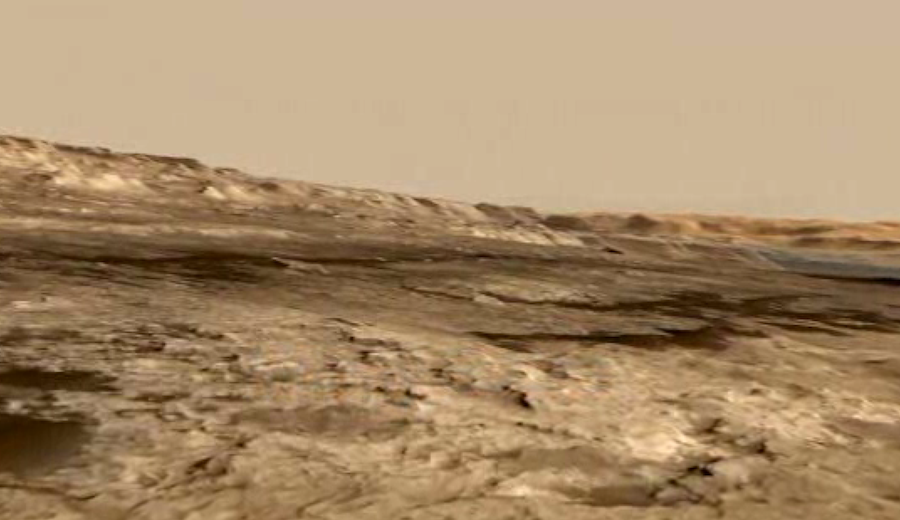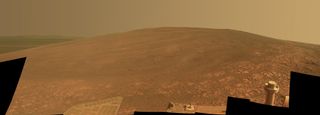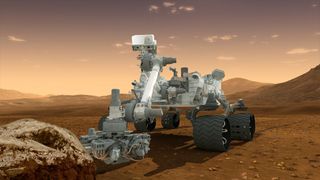Mars Rover Curiosity's Next Destination Named for Planetary Science Pioneer (Video)

NASA's Curiosity rover on Mars is headed for a cluster of strange rock formations that have been newly named in honor of a pioneering planetary geologist who died earlier this year.
The Curiosity rover is in the midst of a long journey to Mount Sharp, a mountain that looms 3 miles (5 kilometers) above the Red Planet's surface and could hold clues about the ancient environment of Mars. But before it gets to the towering mountain sometime next year, Curiosity will pass the newly named "Murray Buttes."
The cluster of steep-sided Martian formations that makes up Murray Buttes was named in honor of Bruce Murray, a former director of NASA's Jet Propulsion Laboratory in Pasadena, Calif., where Curiosity's mission operation are based. According to a new NASA video description of Curiosity's journey, each of these rocky knobs near the foot of Mount Sharp could fill up the length and width of a football field and stretch up to the height of the goal posts. [See Curiosity's latest photos from Mars]
"It will be a visually intriguing area for both the science team and the public," Curiosity science-team member Ken Herkenhoff, of the U.S. Geological Survey's Astrogeology Center, Flagstaff, Ariz., said in a statement. "I think it will look like a miniature version of Monument Valley in Utah."
Bruce Murray was the head of JPL from 1976 to 1982, an important era of planetary exploration. In the summer of 1976, Viking 1 and 2 touched down on Mars and became first American spacecraft to land on the Red Planet. Murray also oversaw the launch of Voyager 1 and 2, the most far-flung man-made objects, and he co-founded the Planetary Society with Carl Sagan and engineer Louis Friedman. Murray died on Aug. 29, 2013, at age 81 after a long illness.
"Bruce Murray contributed both scientific insight and leadership that laid the groundwork for interplanetary missions such as robotic missions to Mars, including the Mars rovers, part of America's inspirational accomplishments. It is fitting that the rover teams have chosen his name for significant landmarks on their expeditions," said Fuk Li, NASA's Mars exploration program manager at JPL, in a statement.

NASA also named another area on Mars after the scientist. The space agency's rover Opportunity is currently climbing part of a crater rim now called "Murray Ridge."
Get the Space.com Newsletter
Breaking space news, the latest updates on rocket launches, skywatching events and more!
Scientists aren't just targeting the Murray Buttes for the potentially stunning vistas Curiosity will see. The buttes also happen to be located in what engineers hope will be a safe passage for Curiosity within a risky band of dark sand dunes at the base of Mount Sharp.
"We're trying to find a place where there's a gap in the sand dunes because we don't feel it's safe cross over the sand dunes with the rover; we'd rather do it on hard rock," John Grotzinger, Curiosity's project scientist, explained in the NASA video.
Curiosity's older cousin, the rover Spirit, was doomed after getting caught in Martian sand in 2009. After cracking through hard topsoil, Spirit was left spinning its wheels in loose Mars dirt; engineers on the ground never figured out a way to get Spirit out of the sand trap and its mission ended.
Follow Megan Gannon on Twitter and Google+. Follow us @SPACEdotcom, Facebook or Google+. Originally published on SPACE.com.

Join our Space Forums to keep talking space on the latest missions, night sky and more! And if you have a news tip, correction or comment, let us know at: community@space.com.

Megan has been writing for Live Science and Space.com since 2012. Her interests range from archaeology to space exploration, and she has a bachelor's degree in English and art history from New York University. Megan spent two years as a reporter on the national desk at NewsCore. She has watched dinosaur auctions, witnessed rocket launches, licked ancient pottery sherds in Cyprus and flown in zero gravity on a Zero Gravity Corp. to follow students sparking weightless fires for science. Follow her on Twitter for her latest project.












